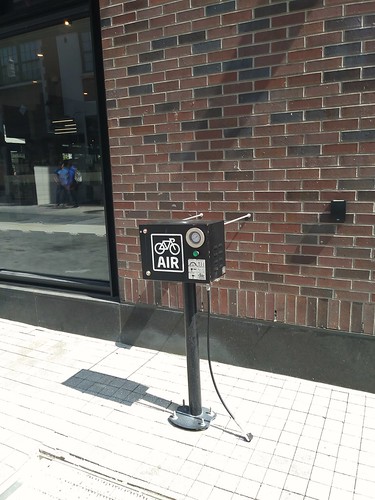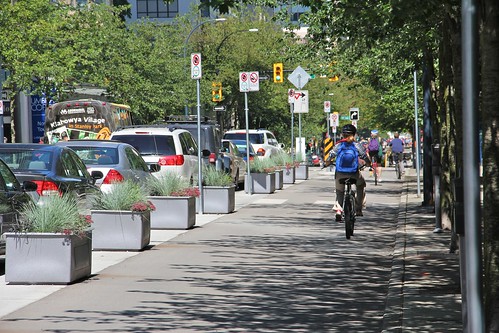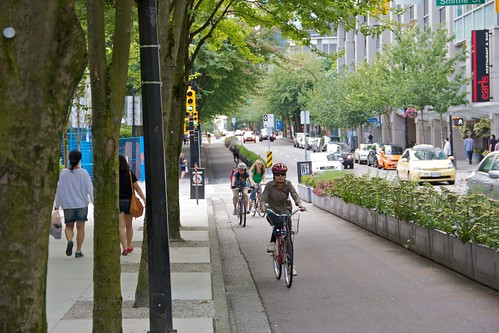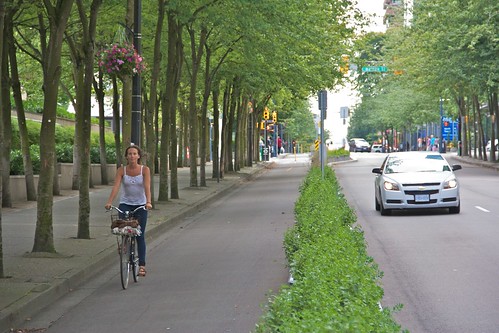Biking for transportation roundup
1. The Washington Post Health and Science section on Tuesday focused on biking--bike commuting primarily but also a sad story of a cyclist recovering from a crash with an automobile as well as helmet safety. By and large the coverage was positive.
-- "Cycling to work means better health and a longer life. Here’s how to get started"
-- "A short bike ride put him on a long road to recovery"
-- "Why wearing a bike helmet may not protect you as much as you think"
 2. I noticed an electric air compressor public bike pump, produced by Bike Fixtation, at The Yards development, on the side of the Philz Coffee Shop off Tingey Street SE.
2. I noticed an electric air compressor public bike pump, produced by Bike Fixtation, at The Yards development, on the side of the Philz Coffee Shop off Tingey Street SE.It's the first of this type of pump I've seen around the DC area. Most of the air pumps put in the public space aren't rated for heavy public use, and fail pretty quickly after being deployed.
In secure situations, such as at Metro Stations and public buildings, an electric air pump is probably the best choice.
3. People are complaining that because of the construction of the Purple Line light rail line, the section of the Capital Crescent Trail/Georgetown Branch Trail between Bethesda and Silver Spring will be closed for the next five years ("Purple Line Construction to Reroute Popular Bike Trail for 4 to 5 years," NBCWashington).
A very circuitous detour route has been developed. But that's not the fault of bicycle planners.
It's the fault of the Town of Chevy Chase, which has fought the Light Rail line for years, and continuing to be obstreperous, refused to authorize an on-street alternative.
Fortunately, experienced bicyclists who know the streets can come up with better alternatives.
4. The Dutch reach/opening the car door with your right hand, to limit dooring of cyclists, is being promoted by cycle advocates in the UK as a way to reduce the likelihood of dooring ("Encourage Dutch reach to stop cyclists car door deaths," Guardian). It works because it forces you to look in the lane abutting the car door, whereas if you open with your left hand, you don't look behind you. From the article:
Cycling UK says people are being killed by people opening their car doors without checking first for passing cyclists. It wants people to be trained to open their doors with their far hands to avoid “car-dooring” riders.
The problem has caused the deaths of eight people – primarily cyclists – in five years and injured thousands more, according to official figures.
 5. Are bright strobe lights for bikes a safety hazard? I didn't think so, but Washington State does. They are banned. I wouldn't have known without coming across a Flickr photo by Joshua Putnam of a notice sticker placed on a lightpole.
5. Are bright strobe lights for bikes a safety hazard? I didn't think so, but Washington State does. They are banned. I wouldn't have known without coming across a Flickr photo by Joshua Putnam of a notice sticker placed on a lightpole.6. The Chicago Metropolitan Agency for Planning, the MPO for "Chicagoland," calls our attention to two international publications on best practices in bicycle planning.
Global Environment for Walking and Cycling: Policies & realities from around the world is published by the United Nations Environment Program.
The Brazilian chapter of the World Cycling Alliance have published the guide How to Include Cycling in Urban Mobility Plans, with the assistance of the Instituto Clima e Sociedade. The publication is part of the organization's campaign to ensure that bicycling is included within all scales of transportation planning.
And separately I came across a publication by the UN Habitat program, Global Report: Planning and Design for Sustainable Urban Mobility on Human Settlements (2013).
7. A Guardian Bike Blog report ("How much could commuter cycling increase in your part of England") discusses the (UK) Propensity to Cycle software application, which analyzes routes and areas according to four different scenarios. From the article:
The Government Target scenario assumes a doubling of cycle commuting nationally – the Department for Transport’s current aim. The tool identifies where those extra trips might take place, based on how long and hilly commutes are in each area.8. The article also provides a link to an important journal article, "Cycling provision separated from motor traffic: a systematic review exploring whether stated preferences vary by gender and age," Transport Reviews, 37:1 (2017), which makes the point that to increase the take up of bicycling for transportation by people interested but less likely to do so in high traffic situations, more emphasis needs to given to the creation of separated bicycle infrastructure.
Gender Equality calculates how cycling levels would change if women were as likely as men to cycle every commute between any two locations.
The Go Dutch and Ebikes scenarios are more ambitious. Go Dutch shows what would happen if we reached average Dutch commuter cycling rates in England, accounting for differences in trip distances and hilliness between the two countries. Ebikes adds to Go Dutch the potential for mass electric bike ownership to facilitate longer and hillier trips, based on data about their use in the Netherlands and Switzerland.
Under the Go Dutch scenario, nearly one in five people across England would cycle to work – around a sixfold increase. Under Ebikes, it’s more than one in four. Distance and hilliness aren’t the main barriers stopping people cycling to work in England, although some areas (such as Cornwall and Devon) may need an extra electric bike boost as well as better infrastructure and policy support to reach Dutch levels of cycling.
9. Cyclists want a more comfortable bike route configuration along the I-66 Freeway. The Washington Post reports ("Biking advocates worry I-66 expansion puts a bike trail too close to traffic") that cycling advocates want to move the proposed bike lane extension from within the right of way of the freeway to outside of it, outside of the "barrier walls." Residents tend to be opposed, fearing cyclists as outsiders and not wanting to give up more land.
From the standpoint of encouraging cycling for transportation, the cycling advocates have a point, especially from the perspective of the quality of the environment for biking. Claudio Oddo of the Fairfax Alliance for Better Bicycling produced a video simulation of how the current plan would work in place. It's not pretty.
VDOT is concerned that design changes will delay the highway expansion program. From the article:
The bike path, part of the $2.3 billion interstate expansion project, has drawn cheers and criticism from biking aficionados who welcome the addition of the trail but say, if built as proposed, users will be too close to cars whizzing by on the interstate and exposed to toxic exhaust fumes.10. DC considering adding "dockless bike share" to the city's bicycling mix. There are two forms of bike sharing systems. Dock-based systems are "hardened" and designed to reduce the likelihood of vandalism, as earlier forms of bike sharing failed because a number of "users" wrecked or stole the bikes. Dockless systems provide for a kind of "free-form" locking.
For about five of the project’s 22.5 miles, the trail would be squeezed between the highway and the concrete wall that will serve as a buffer between traffic noise and adjacent neighborhoods.
“It is air pollution, it’s noise, small particles that get kicked up from the highway,” said Bruce Wright, a member of the Fairfax Alliance for Better Bicycling. “Imagine riding on this trail and there is really no place to go if you have a problem. You are right next to a very tall soundwall, and you are right next to a jersey barrier.”
-- DDOT Seeks Public Feedback on Dockless Bikeshare
In China, the systems have suffered from a great deal of "dishonorable use," and the bikes have been abandoned by users at a high rate, bringing the systems to a standstill ("As Bike Sharing Brings Out Bad Manners, China Asks, What’s Wrong With Us?," New York Times).
Now the companies are aiming to bring their programs to Europe and North America, although I seem to recall the first deployment in the UK didn't go so well. Programs are moving forward in Cambridge, Oxford, and London, among other places.
For me, I think the real problem in the US is that outside of a couple of cities, bike share isn't experiencing significant use. The point of a dock based system is to "focus" use in areas where you want to encourage sustainable mobility. Dockless systems disconnect that policy goal from the system footprint.
I do think it's worth testing. I can't remember what I thought about the concept of one-way car sharing by Car2Go. I do remember being asked about it by a then-DDOT staffer and I said it's worth testing. As a user, I have to say I love it!
Abandoned dockless bikes in Shanghai have been moved to a storage yard. Different colors represent the different systems.
But early on, Car2Go vehicles would "accumulate" at the outskirts of the system. But as more users joined, this problem worked itself out.
The same could be true of dockless bike share, if lots of people were regular bikers. But we don't have lots of regular cyclists in DC or in most other US cities.
But I think the issue with take up for biking as transportation isn't merely "access to bicycles," it's something more. If it weren't, then we'd have at least double the number of regular cyclists, compared to what we have.
However, the advantage of dockless bikes would definitely obtain in outer areas and in areas with lower station density. For example, were I to use DC's bike share system, I'd have a half mile walk to and from the station. With dockless, I could lock a bike up on my block. Then again, I can do the same with my own bike, although with bike share, you offload the cost of maintenance, storage, and vandalism to the operator.
11. Support for the Idaho Stop. The Washington Post article ("Bicyclists learn from bicyclists to break traffic laws. But perhaps the law should learn from them, researcher says") on dockless bike share references research on why bicyclists run stop signs and red lights. It's very interesting.
-- "Scofflaw cycling: illegal but rational," Journal of Transport and Land Use, 10:1 (2017).
Abstract
Nearly everyone has jaywalked, rolled through a stop sign, or driven a few miles per hour over the speed limit, but most such offenses face no legal consequences. Society also tends to see these relatively minor infractions that almost all people make—though they are unmistakably illegal—as normal and even rational. Bicyclists who break the law, however, seem to attract a higher level of scorn and scrutiny. While the academic literature has exhaustively covered unlawful driving behaviors, there remains little research on bicyclists who break the rules of the road. This paper examines rule-breaking bicyclists and the factors associated with such behaviors. We also explore the question: are bicyclists making rational, albeit illegal, choices—similar to most drivers and pedestrians—or are bicyclists reckless and dangerous? Because it’s proven effective for reaching hard-to-reach populations, we employed a snowball-sampling framework and an online, scenario-based survey completed by nearly 18,000 respondents. Via multi-level statistical analyses, our results suggest that younger people and males tend to exhibit higher levels of illegal bicycling behavior, but even when combining high-risk factors, the overwhelming majority of bicyclists are not reckless. Controlling for the context and social norms of the city where one lives tends to outweigh individual bicyclist characteristics such as race/ethnicity and income. Unlawful drivers and pedestrians tend to rationalize their behaviors as time saving; bicyclists similarly rationalize their illegal behaviors but were more inclined to cite increasing their own personal safety and/or saving energy. Most bicyclists can generally be described as rational individuals trying to function safely and efficiently given the context and norms of where they live and the transportation system put in front of them.
12. Hornby separated bike lane in Vancouver has some nice landscaping treatments. (I don't think we'll be seeing this kind of treatment along I-66.) A photo of this cycletrack was in planning materials produced by the San Francisco Municipal Transportation Agency for their Folsom-Howard Streetscape Project. Thank you to Anthony Easterbrooks and Kelli Rudnick from the SF Department of Public Works for tracking this down. Anthony says he was clued into the image from this article, "Top 5 Best Safety [Treatments] for Urban Cyclists," from Momentum Magazine.



13. Problems with the Baltimore bicycle sharing system. The Baltimore Sun reported earlier in the summer that only about 20% of the bikes were readily available, either out of service or not properly returned--the system dedicated two employees to retrieving missing bikes. The introduction got a lot of press because it was one of the first larger scale deployments of e-bikes.
The system has just been shut down for a month for security improvements ("Baltimore Bike Share temporarily shutting down amid thefts").
The Baltimore Business Journal is also reporting on the matter, "Why most of Baltimore's bike share racks are sitting empty" and this article, which has restricted access, "What can Baltimore do to improve its bike share system? Other cities weigh in."
Labels: bicycle and pedestrian planning, sustainable mobility platform, transportation planning, urban design/placemaking





0 Comments:
Post a Comment
<< Home